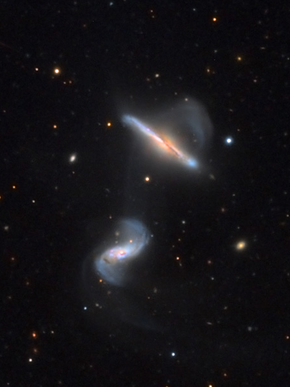NGC 6286
Appearance
| NGC 6286 | |
|---|---|
 NGC 6286 (above) and NGC 6285 (below) as seen through the 0.81 m Schulman Telescope at Mount Lemmon Observatory. | |
| Observation data (J2000 epoch) | |
| Constellation | Draco |
| Right ascension | 16h 58m 31.4s |
| Declination | +58° 56′ 11″ |
| Redshift | 0.018349±0.000053 |
| Heliocentric radial velocity | 5501±16 km/s |
| Galactocentric velocity | 5689±18 km/s |
| Distance | 252 million light years (77.5 million parsecs) |
| Apparent magnitude (V) | 12.05 |
| Absolute magnitude (V) | −22.36 |
| Characteristics | |
| Type | Sb/P |
| Size | 96,000 light years |
| Apparent size (V) | 1.30′ × 1.2′ |
| Other designations | |
| UGC 10647, MCG 10-24-84, ZWG 299.40, PGC 59352, ARP 293, IRAS16577+5900 and PRC C-51 | |
References: NASA/IPAC extragalactic datatbase, http://spider.seds.org/ | |
NGC 6286 is an interacting spiral galaxy located in the constellation Draco. It is designated as Sb/P in the galaxy morphological classification scheme and was discovered by the American astronomer Lewis A. Swift on 13 August 1885. NGC 6286 is located at about 252 million light years away from Earth. NGC 6286 and NGC 6285 form a pair of interacting galaxies, with tidal distortions, categorized as Arp 293 in the Arp Atlas of Peculiar Galaxies.[1][2][3][4]
Gallery
-
NGC 6286 and NGC 6285 are named Arp 293.[5]
-
An uncropped version of the image showing the interacting galaxies and UGC 10641, a flat galaxy at the top left area.
See also
References
- ^ "Object No. 1 – NGC 6286". NASA/IPAC. Retrieved 4 October 2015.
- ^ "Revised NGC Data for NGC 6286". Seds. Retrieved 4 October 2015.
- ^ "NGC 6286 (= PGC 59352, and with NGC 6285 = Arp 293)". cseligman. Retrieved 4 October 2015.
- ^ "NGC 6286 & NGC 6285". PBase. Retrieved 4 October 2015.
- ^ "A Close Relationship". www.spacetelescope.org. Retrieved 25 November 2019.
External links
 Media related to NGC 6286 at Wikimedia Commons
Media related to NGC 6286 at Wikimedia Commons

![NGC 6286 and NGC 6285 are named Arp 293.[5]](http://upload.wikimedia.org/wikipedia/commons/thumb/8/8a/A_Close_Relationship_NGC_6286.tif/lossy-page1-120px-A_Close_Relationship_NGC_6286.tif.jpg)
